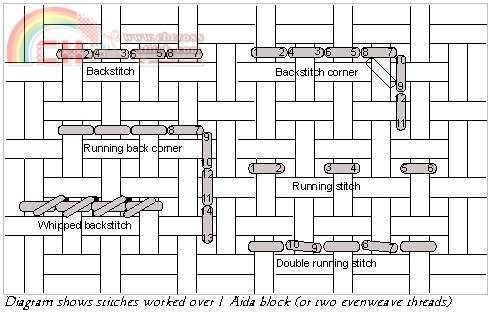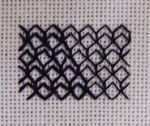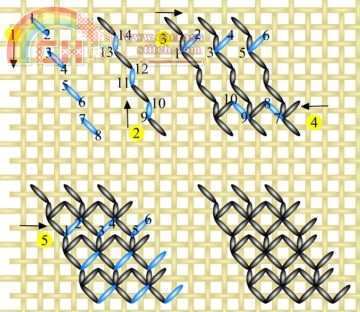|
|
How to do blackwork
Taken from Needlework tips and techniques
As a beginner there are various questions you may want to ask. For example do you start with the outlines or the fill patterns?
Outlines
Getting those outlines in place first is the best place to start. If you are a keen cross stitcher this will probably seem backwards but when you think it through it makes sense. The outlines give you an edge to work up to when you fill the area with patterns. You dont need to count the number of repeats and work out where each one finishes, you just stitch until an outline stops you. Easy!
Some blackwork designs, however, dont use outlines.
Fill Patterns
Are you hesitant to try this type of embroidery because they look so complex?
Let me reassure you that they really arent as difficult to stitch as you might think. Like everything in life if you have a plan to work to, things get a lot easier! I am going to share my plans with you over the next few pages and you will find that following a logical journey through the pattern makes it simple to stitch. Rather than jumping in with both feet take time to study a pattern before you start stitching it. Work out where the vertical, horizontal and diagonal lines go. See if there are any isolated stitches which cant be worked at the same time as the rest of the pattern. A little planning goes a long way to making blackwork simple and relaxing to stitch.
What stitch should I use for blackwork outlinesPersonal preference plays a part here. Ideally you would double running stitch (also known as Hobein stitch) as it gives a clean, sharp outline which looks the same on the back and front of the work.
However you could also use backstitch, but would get a thicker line on the back of your work. The main disadvantage of backstitch is that it tends to show through from the back when you turn a corner, especially if you are working on finer fabrics.
You can "cheat" a little and work a variation called running back stitch, shown in the diagram below, so that the shadowing at the corners is removed.

Blackwork pattern and toneAs most blackwork tends to be monochromatic, tonal contrast is essential. Using the right tones can make or break a design. You could compare blackwork with a pen and ink drawing, where tones are built up with lines and cross-hatching. The darkest areas of a drawing may even be solidly inked in; an effect that can be imitated in a blackwork design by using cross stitch. The lightest areas, by comparison, can be left completely empty. Generally if the stitches in a pattern are close together it will appear darker than one where the stitches are spaced apart. Some patterns need to be used in a large area for the full effect to be seen whilst others would take a long time to stitch if used for anything other than a small section of a design.
Example:
Arrows and Diamonds

To help you learn blackwork embroidery lets build your library of blackwork fill patterns worked in double running stitch.
This pattern is useful for small areas of a design, and gives a dark overall effect. It doesnt have any obvious direction in its final appearance and can therefore be used in an area of any shape. If, however, it had been made up of distinctly vertical rows it would better in an upright shape rather than a horizontal one. Try to keep the overall shape of the design section in mind when you choose your blackwork fill patterns to get the best effect. This pattern is worked in vertical and horizontal rows. Start working it by following row 1 on the step by step diagram above. Each stitch is worked over 1 Aida block (as shown) or 2 evenweave fabric threads. Starting with step 2 of the diagram I have coloured all the existing stitches in this pattern in black, with the new stitches for the current row in blue. So for step 2 fill in the gaps with vertical stitches. Repeat these steps to fill the area with the first layer of the pattern. For step 3 we will work horizontally by working diagonal stitches (again the current row is in blue). Be careful to stitch them in the right place, I can attest to the fact that it doesnt work too well otherwise!
Return as in step 4 to complete the pattern.

A free pattern for you to try out:
http://www.pindiy.com/thread-2942-1-1.html |
Rate
-
View Rating Log
When someone visits this page from a link you share, you will be rewarded
|